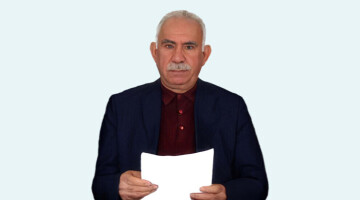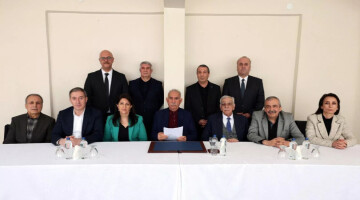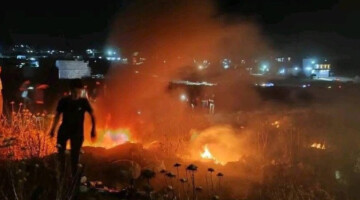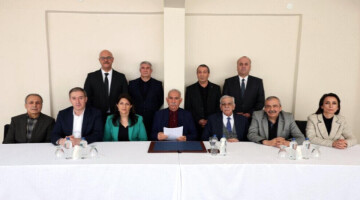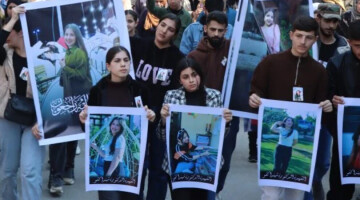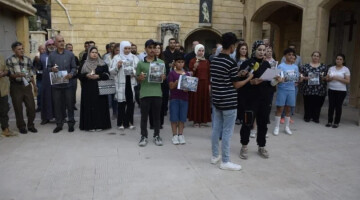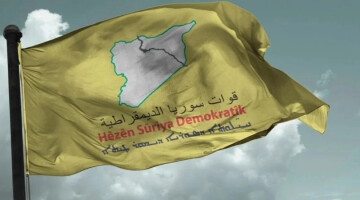The 7.8 and 7.7 magnitude quakes, centred in the Pazarcik and Elbistan districts of North Kurdistan’s Maras province, were strongly felt in Egypt, Lebanon, Syria and Iraq as well. The earthquakes caused great destruction in the Syrian provinces of Idlib, Aleppo, Hama, Latakia and Tartus, as well as in the cities of Shehba, Kobanê, Manbij and Raqqa controlled by the Autonomous Administration of North and East Syria, and in occupied Afrin.
The latest situation in Syria and North and East Syria is as follows:
OCCUPIED REGIONS
The cities of Afrin and Idlib, occupied by the Turkish state, are among the places devastated by the earthquakes. While hundreds of buildings were destroyed, the death toll and the scale of the destruction in these regions are not disclosed. According to information obtained from the Afrin Human Rights Organization, there is a humanitarian disaster in Afrin, where hundreds of people were trapped under the rubble.
Afrin: Turkish-occupied Afrin is the most affected city by the earthquake which inflicted serious damage to the city centre and the districts of Jindires and Mabata. The number of casualties in the city is not revealed. 257 buildings were destroyed completely in Jindires district, which is 20 kilometres away from the city centre. Reports say that at least 756 people lost their lives under these buildings and thousands of people are still under the rubble. 70 percent of the Kaxırê village in the southwest of Mabata was also destroyed. It is reported that hundreds of people are still under the rubble as no reliable information can be obtained from the village.
Idlib: The regions of Atarib, Sarmada, Harim, Bisnia, Salqim, Azmarin and Keferhom in the city of Idlib, which remains under the occupation of Turkey-backed Hayat Tahrir Al-Sham (HTS), were also damaged by the earthquakes. It is reported that 718 buildings were destroyed in the city where 195 towns and villages were affected by the earthquakes. The Al-Tilol village was flooded as the Asian Dam on the Turkey-Syria border was partially damaged. The number of deaths and injuries remains unknown, like other occupied territories.
REGIONS HELD BY DAMASCUS GOVERNMENT
The provinces of Aleppo, Hama, Latakia and Tartus held by the Damascus government were significantly damaged. The Ministry of Health reported that 1,408 people lost their lives and 2,341 were injured in the areas under their control due to the earthquakes.
Aleppo: The neighbourhoods of Al Shaar, Musharaqa, Paradise, Salahaddin, Al Kelasa and Aziziye in the east of Aleppo were devastated by the earthquakes. Damascus government officials reported that about 4,000 people lost their lives and around 7,000 people were injured or unaccounted for.
Latakia: The town of Jabla and the neighbourhood of Ramla Janubi are the most affected areas. 102 buildings in central and rural Latakia were destroyed. While 506 people lost their lives, 792 others were injured.
Hama: The Erbain region in the north of the city is the most affected area. 47 people lost their lives, and 75 others were injured in Hama.
AUTONOMOUS ADMINISTRATION OF NORTH AND EAST SYRIA
The Health Committee of the Autonomous Administration of North and East Syria (AANES) announced that 6 people lost their lives and 57 people were injured in the areas under their control. In the Sheikh Maqsoud (Şêx Meqsud) and Ashrafiyah (Eşrefiye) neighbourhoods of Aleppo, 6 people lost their lives and 47 people were injured. 5 people were injured in Shehba, 3 in Kobanê and 2 in Manbij.
6 people lost their lives in Babinis and Til Qerah villages of Shehba Canton and in the Sheikh Maqsoud and Ashrafiyah neighbourhoods where Kurds predominantly live.
2,000-YEAR-OLD CASTLE DAMAGED
The Najim Castle, located on the Euphrates River and 115 kilometres from Aleppo, was also affected by the earthquake in North and East Syria. A part of the eastern wall of the castle, which dates back to 68 AD, was demolished.
BAB AL-HAWA BORDER CROSSING AFFECTED
The Bab Al-Hawa Border Gate between Turkey and Syria under Turkish occupation in the city of Idlib was also affected by the earthquake. The roads leading to the border crossing were damaged. Aid to earthquake victims in Syria is delivered through the Bab Al-Hawa Border Gate.
625 SCHOOLS DAMAGED
Many schools run by the AANES and the Damascus government were also damaged by the earthquakes. According to the data collected by the North and East Syrian Education Committee, 15 schools in Ayn Issa, Kobanê and Sirin in the Euphrates Region were damaged, and education has been suspended for 7 days. 138 schools were damaged, and 6 schools were closed in Manbij. 9 schools were damaged in Deir ez-Zor. In Raqqa, 115 schools were damaged, and 36 of them were closed. 41 schools were damaged in Tabqa, but schools will continue education once engineers finish the repair work. In Shehba Region, 15 schools were damaged, and 5 schools became unusable. In the Cizre Region, 39 schools were damaged.
According to official data released by the Damascus government, 248 schools were damaged in the areas under their control.
MUNICIPALITY STEPS INTO ACTION
The Local Administrations and Environmental Management Committee of North and East Syria provided the following information to ANF:
Afrin-Shehba Region: Shehba People's Municipality cooperated with the assembly and commune organizations in the region to help earthquake victims. Construction materials such as cement, soil and gravel were provided for the local people for the repair of the damaged structures.
Euphrates Region: A joint committee was established in cooperation with the Euphrates Region Chamber of Engineers. People in the Euphrates region applied to the municipality for the repair of 68 buildings. Municipal teams checked 88 buildings and reported that 15 buildings, including petrol stations and schools, were damaged. The wreckage of 31 damaged structures was removed.
Tabqa: The Emergency Teams and firefighters affiliated with the Tabqa Local Administration Committee assessed the extent of the damage caused by the earthquakes. An emergency committee was established under the Local Administration Committee. Moreover, a committee was formed to identify and examine the damaged buildings and to take the necessary measures. A damaged earth-sheltered house was demolished, and 7 houses were repaired. Two buildings in the city centre were evacuated as a precaution.



